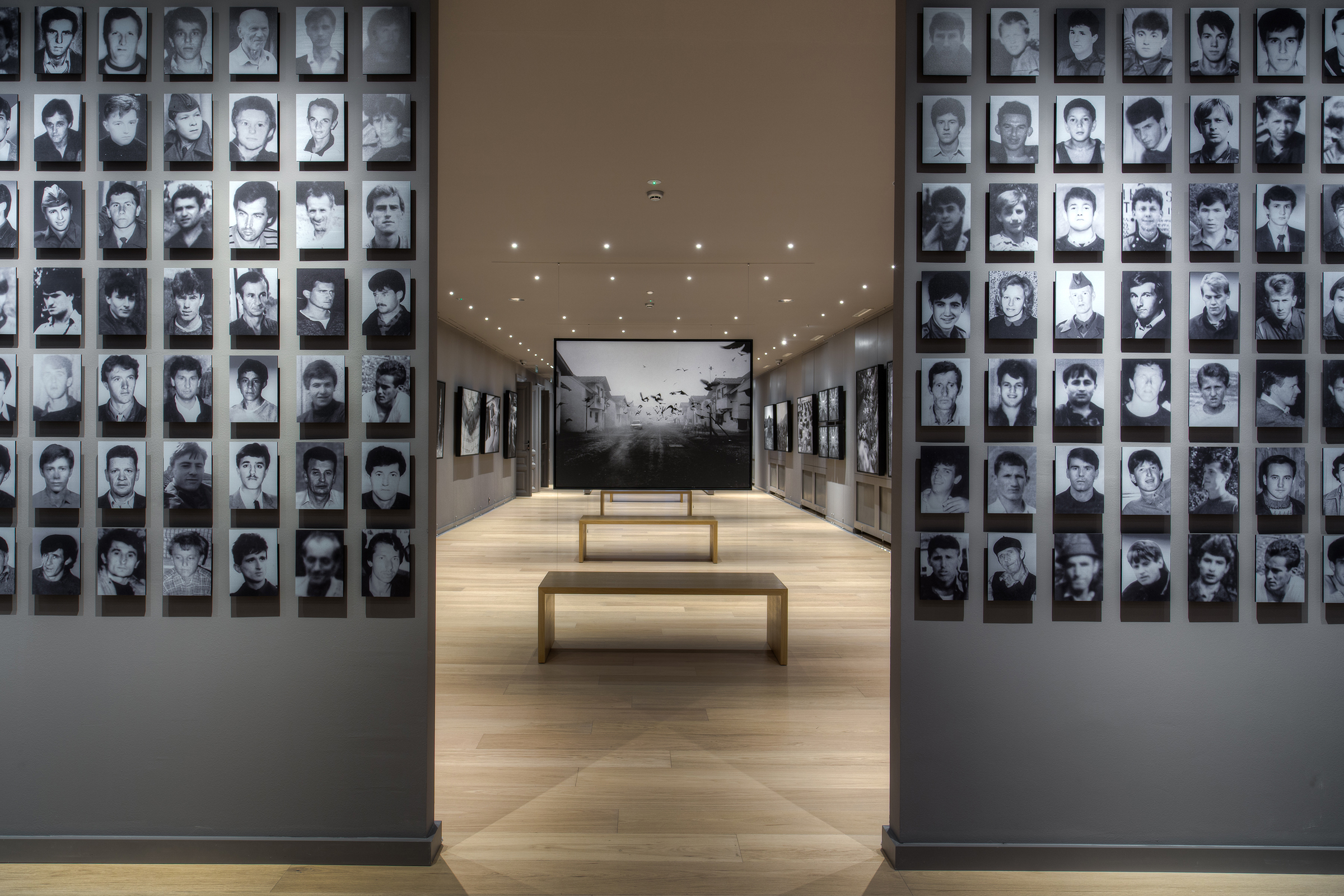Permanent Exhibition “Srebrenica”

The permanent exhibition Srebrenica is an artistic documentary view of the suffering and life of the Srebrenica survivors after 11 July 1995. The multimedia setting includes the following sections:
“Srebrenica – genocide at the heart of Europe” (Tarik Samarah)
Photographs by Tarik Samarah from the Srebrenica series offer an insight into fragments of the still unresolved trauma of Srebrenica. What happened there was so horrific, so monstrous, that every description of the events fails their essence and eliminates their horror. The photographs remove any mediator between the observer and the observed, showing the emptied landscape of reality in Srebrenica. The black-and-white technique expresses the boundary between life and death – the reduction of colors brings us into the world of grey, where all norms of humanity cease to exist. That very insight into liminality is fragmentary, and it does not permit the creation of a single, well-rounded narrative. Excerpts from everyday life of the survivors, landscapes of the crime, scenes depicting discoveries of the mass graves… are but a small part of the content of these photographs. Images of the Srebrenica fields of death do not allow an observer to be a passive consumer of the story; instead, they produce a witness. Anticipation of the trauma is possible, since the photographs depict the aftermath of traumatic events, and not the event itself. True understanding of the horrors is impossible, since they remain beyond the boundaries of everything conceived by the human mind; a road towards understanding trauma implies collecting the scattered pieces of reality.
Tarik Samarah, photographer and founder of the Gallery 11/07/95, was born in Zagreb and has been living and working in Sarajevo for the past 30 years. His primary focus is on artistic and documentary photography and “Srebrenica – genocide in the heart of Europe” project – a series of black-and-white photographs documenting the aftermath of the Srebrenica genocide, is considered to be his most successful work to-date. His photographs have been exhibited in many renowned art galleries and museums across the world, both independently and in collective exhibitions. In 2003, the exhibit was donated to the Memorial Centre in Potočari, as the first work of art to be exhibited in the future museum. On the tenth anniversary of the fall of Srebrenica, his photographs were exhibited in the U.S. Holocaust Museum in Washington, and subsequently displayed in the UN Headquarters in New York, in Cape Town, in Geneva in the Dutch Parliament in The Hague, Gallery du Jour in Paris, in the Illinois Holocaust Museum & Education Center in Chicago and in many other places. In 2005 he exhibited the images of the Srebrenica massacre on large commercial billboards in several cities in Serbia including Belgrade, Čačak, Niš and Novi Sad. These posters carried the message: “To see, to know, to remember Srebrenica 1995-2005”, and were used to raise awareness of the events that took place during the Srebrenica genocide. Samarah’s photographs also went around the world on the covers of various scientific and research books dedicated to the Srebrenica genocide. Today, they form the permanent exhibition in the Gallery 11/07/95 located in Sarajevo; the gallery represents the final goal and summation of Samarah’s work on the topic.
The Wall of Death (Memorial center Srebrenica – Potočari)
The sixteen meter long wall contains the names and ages of the 8372 people killed in Srebrenica. Names and ages were collected by the Memorial Center in Potocari.
Portraits of victims (Association of Mothers of Srebrenica and Žepa)
Part of the permanent exhibition are also 640 personal photos compiled by the mothers of Srebrenica. The photos show how men of all ages were killed in Srebrenica – just because of their names.
Srebrenica – Mapping genocide
“Mapping genocide” is an interactive study of genocide made up of maps which offer a detailed description of Srebrenica genocide through texts, drawings, photographs and videos. The maps are organized in chronological order and in line with the methodologies adopted by institutions collecting and archiving documents related to Srebrenica genocide and genocide in general – as identified by number of a respective studies. Each map has key points containing particular evidence (text files, photos, video clips).
Genocide Film Library (Cinema for Peace foundation)
Genocide Film Library is a project of the Cinema for Peace foundation, which offers personal stories of the survivors of Srebrenica. Created as a model of oral history, the project Genocide Film Library offers the life experiences of the survivors as an important part of the process of the documentation of the genocide.
Srebrenica Memorial Film (Leslie WoodHead)
“Srebrenica Memorial Film” is a documentary featuring first-hand accounts and previously unseen footage of the 1995 genocide. Documentary was directed by an award-winning British documentary filmmaker Leslie WoodHead.